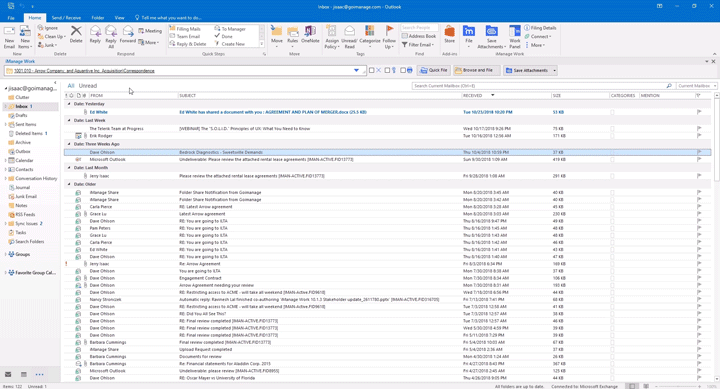Linking folders
You can link folders and sub folders in your Microsoft Outlook mailbox to an iManage Work folder so that when messages are added to the filing folders, they are copied or moved to the corresponding iManage Work folder automatically. Alternatively, a delegate can create linked folders in Microsoft Outlook on your behalf. The linked folder in Outlook that your delegate creates has you (the mailbox owner) as the folder owner. All existing and subsequent emails in the linked folder are automatically filed to the iManage Work folder to which it is mapped.
NOTE:
The Link to iManage option:
- Is not available for the default Outlook folders such as your Inbox, Sent Items, Deleted Item folders, and so on.
- From 10.2.1 onwards, the suffix that is added to linked folders by default is changed to [Work] from [WorkSite]. When Outlook starts, previously linked folders are renamed from <FolderName> [WorkSite] to <FolderName> [Work]. This change occurs for the currently logged on server. If you switch the server and the
imEMM.configfile has the "[Work]" suffix, the folders mapped on that server get changed too. If you previously changed the folder suffix to something else, for example [Microsoft], the customized suffix remains unchanged. - Appears disabled till Outlook connects to an iManage Work Server. To ensure that Outlook connects to the iManage Work Server at startup and the Link to iManage option is enabled, set the value of the
LoginOnStartupoption to 0. For more information, refer to the imEMM.config section in iManage Work Desktop for Windows Customization Guide. - When you add emails to a linked folder and if you have more than 100 linked folders, the messages may not sync immediately. This is a Microsoft Exchange limitation. If you move emails to a linked folder and if they are not filed promptly, use the File Now to sync the linked folder as required. Select Outlook mail folder and then select Linked to iManage to access the File Now option as shown in the following figure. This option is available when you are using iManage Work Desktop for Windows 10.7.0 or later.
Figure: File Now
If the Flexible Folders feature is enabled for a workspace, the Select button is enabled only if you have drilled into an existing Ad-Hoc Folder for which you have read/write permissions to create folders. If the Flexible Folders feature is not enabled, the Select button is enabled only if you have read/write access to the folder and the relevant permissions to create public/private folders.
Right-click the Outlook mail folder in the Outlook tree, and select Link to iManage. A dialog box for selecting the iManage location appears. Alternatively, select Yes on the link to iManage confirmation dialog box that appears when you create a folder or sub folder in Outlook.
- Select the filing destination folder in iManage Work and choose Select. You are redirected to the Link Folder to iManage dialog box, and the folder path is updated in the Filing Locations field.
(Optional) Select Browse to select another location. - (Optional) Select or clear the following check boxes:
- Leave messages in Outlook after filing (selected by default): Unless this option is selected, any email messages in the linked Outlook folder are moved to iManage Work and automatically deleted from the Outlook folder after they are filed.
- File messages as Private: By default, emails filed to iManage Work inherit the security policy of the parent folder. Select this option to apply the Private security policy instead.
Map all sub folders: All sub folders in the selected Outlook folder are also mapped. That is, the same sub folder structure is created in the iManage folder, and emails are filed to these sub folders.
NOTE:
This option is unavailable when you select an iManage Work folder in a Ad hoc workspace.
- Select OK. The iManage
 icon, and the word [Work] is appended to the folder name indicating that the folder is linked. The same behavior is also seen for sub folders if you selected the Map all sub folders check box. To view the folder mapping structure, select the Folders tab in iManage Work panel. It shows the recent folders. Select the iManage folder to which you created the link. Drill down the folder hierarchy and you will find that all the sub folders are created inside the mapped folder.
icon, and the word [Work] is appended to the folder name indicating that the folder is linked. The same behavior is also seen for sub folders if you selected the Map all sub folders check box. To view the folder mapping structure, select the Folders tab in iManage Work panel. It shows the recent folders. Select the iManage folder to which you created the link. Drill down the folder hierarchy and you will find that all the sub folders are created inside the mapped folder.
After you link a folder, any sub folders that you create inside this folder are not mapped automatically. You can link these sub folders while creating them at any other time.
See the following animation for more information about linking folders.
